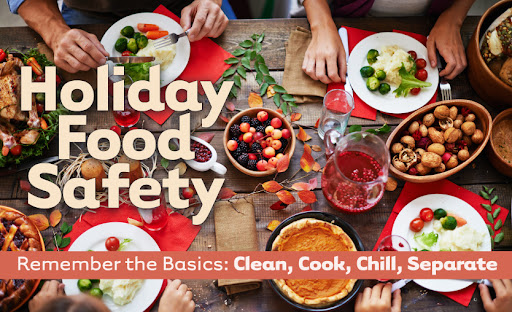Office Safety-Holiday Food Safety
The holidays are here and with some optimistic light at the end of the Covid Tunnel, employees are returning to the workplace and are looking forward to resuming those wonderful and traditional holiday office parties. It’s time for all the baked treats and potluck luncheons! So, I’m going to dish out some tasty tips to keep our employees safe regarding basic food safety and food allergen awareness and avoidance. These are tips you should practice at home, as well as at the office.
What foods cause the majority of allergies?
While more than 160 foods can cause allergic reactions in people with food allergies, the Food Allergen Labeling and Consumer Protection Act (FALCA) has identified the eight most common allergenic foods. These eight foods account for 90 percent of food allergic reactions. They are: milk, eggs, fish (such as bass, flounder, cod), crustacean shellfish (such as crab, lobster, shrimp), tree nuts (such as almonds, walnuts, pecans), peanuts, wheat, and soybeans. You don’t have to disclose grandma’s secret recipe, but it’s not a bad idea to label with ingredients any shared dishes with a 3×5 card if they contain any of the above allergens.
What are food allergies and anaphylaxis?
Anaphylaxis (pronounced an-uh-fil-LAX-is) is a severe, potentially life-threatening allergic reaction. Symptoms can affect several areas of the body, including breathing and blood circulation. Anaphylaxis often begins within minutes after a person eats a problem food. Less commonly, symptoms may begin hours later. Employers should be aware of the potential warning signs of an allergic food reaction and be prepared to call 911 and try to identify what the person may have consumed.
My next tip is on safe food handling and what is called the CORE 4 Clean, Separate, Cook, Chill
CLEAN: Wash hands and surfaces often. Use disposable gloves if possible and change often. Bacteria can be spread throughout the kitchen and get onto hands, cutting boards, utensils, counter tops and food.
SEPARATE: Don’t cross-contaminate. Cross-contamination is how bacteria can be spread. Improper handling of raw meat, poultry, seafood and eggs can create an inviting environment for cross-contamination. As a result, harmful bacteria can spread to food and throughout the kitchen leading to a foodborne illness.
COOK: Cook to the safe recommended internal temperature. Food is safely cooked when it reaches a high enough internal temperature to kill the harmful bacteria that cause foodborne illness. Use a food thermometer to measure the internal temperature of cooked foods.
CHILL: Refrigerate promptly. Refrigerate foods quickly, because cold temperatures slow the growth of harmful bacteria. Do not over-stuff the refrigerator. Cold air must circulate to help keep food safe. Keeping a constant refrigerator temperature of 40 °F or below is one of the most effective ways to reduce the risk of foodborne illness. Use an appliance thermometer to be sure the temperature is consistently 40 °F or below. The freezer temperature should be 0 °F or below.
Remember to clean out that shared office fridge that is full of tasty leftovers at least weekly. The two links below provide additional details and info to help keep your employees, family and friends safe food wise throughout the year.
